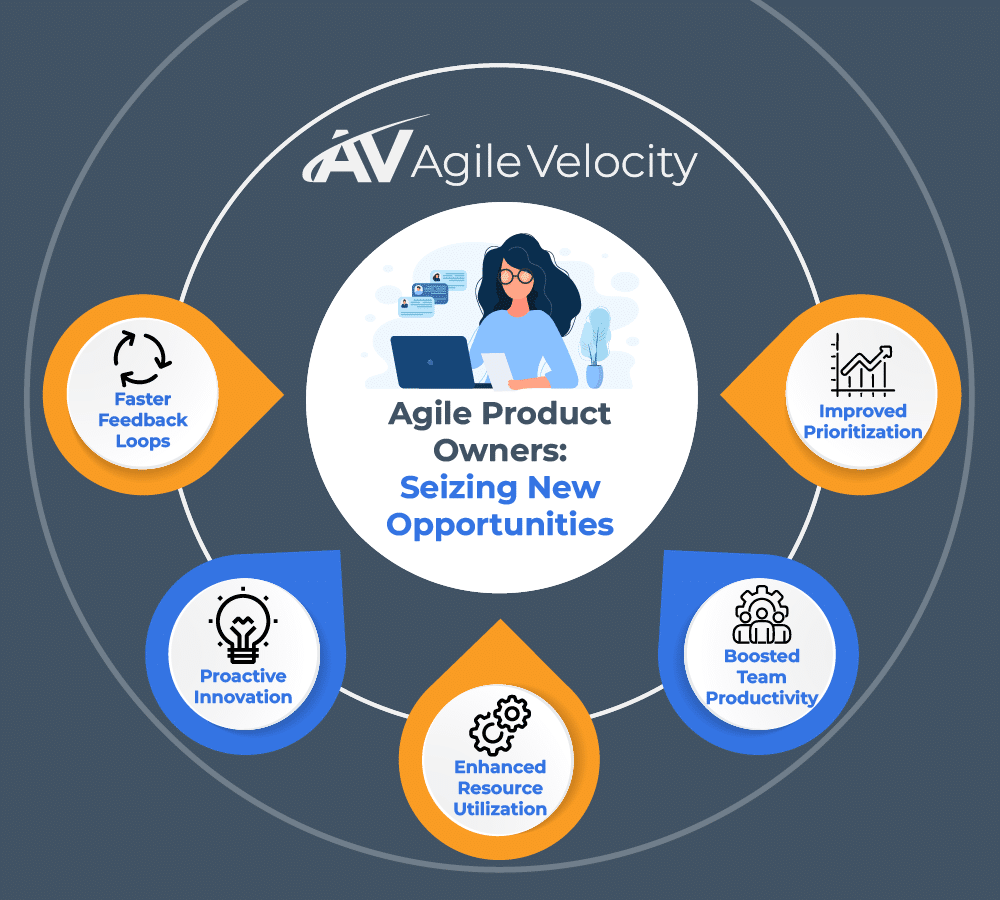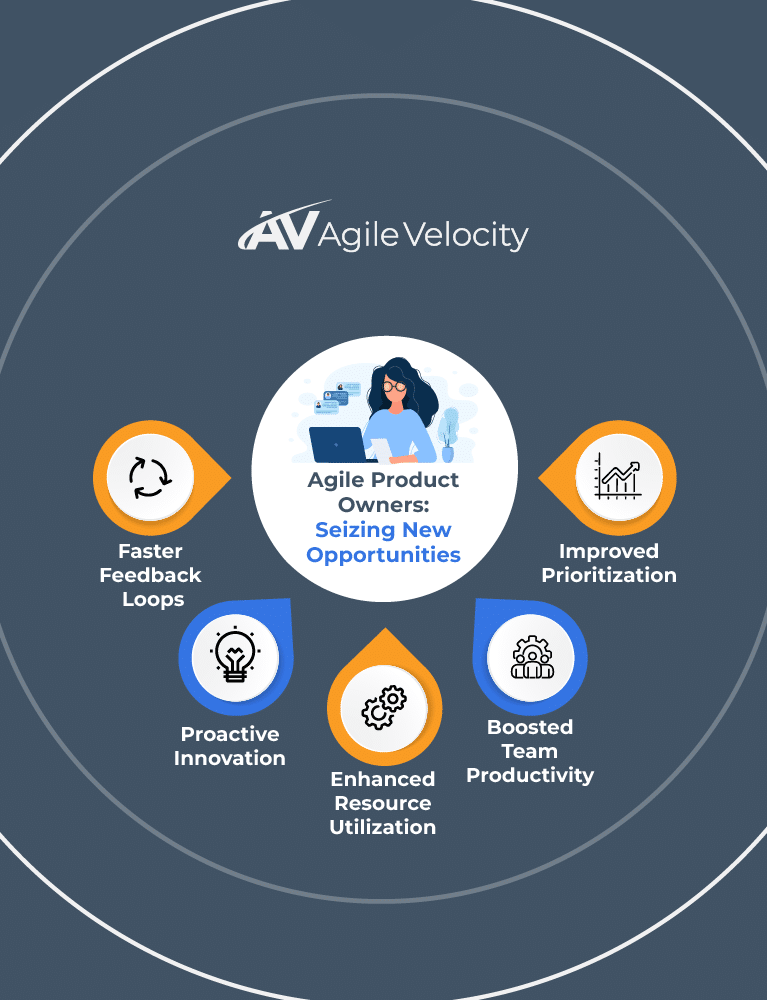Modern techniques have reshaped how teams plan, develop, and deliver value for years. In fact, when organizations embrace modern Agile techniques, they build a resilient foundation that endures even in the face of rapid technological change. As Artificial Intelligence (AI) continues to transform industries, the Agile Product Owner’s role becomes even more vital. AI-driven organizations need leaders who can bring together technical teams, AI specialists, and business stakeholders to ensure the seamless integration of AI technologies while upholding core Agile principles.
To further accelerate innovation, many organizations are now exploring AI-enabled Agile frameworks that merge AI integration with well established Agile approaches, boosting both efficiency and competitive edge. A recent report from Stanford University shows that corporate investments in AI have risen significantly over the years – with U.S. private AI investment reaching $109 billion in 2024 – reflecting the growing scale of AI initiatives.
This article explores how the role of the Agile Product Owner is evolving in AI-powered environments. It covers the essential skills Product Owners need, practical strategies to navigate AI integration, and actionable tips to ensure organizational agility and operational excellence. You’ll discover how fostering collaboration, leveraging data-driven insights, and staying aligned with Agile values can empower teams to achieve meaningful results in this dynamic landscape.
The Evolving Role of the Agile Product Owner in AI-Driven Organizations
The Agile Product Owner has always been a pivotal link between business objectives and technical teams, ensuring that products deliver value while maintaining alignment with organizational goals. In AI-driven organizations, however, this role has expanded to include new dimensions, such as understanding data science fundamentals, addressing ethical considerations, and navigating advanced decision-making processes. The integration of AI introduces opportunities to automate tasks, identify patterns in data, and make predictive decisions, but it also requires Agile Product Owners to build strategies that incorporate these innovations while staying true to Agile principles.
In traditional Agile frameworks, Product Owners are responsible for managing the Product Backlog, gathering requirements, and collaborating with the Scrum Team or Kanban practitioners to deliver iterative value. With AI in the picture, these responsibilities now include several tasks:
- Grasping the basics of AI technologies to evaluate potential use cases and feasibility.
- Balancing data-driven experiments with short Sprints or Iterations to ensure innovation does not derail the workflow.
- Facilitating collaboration with AI specialists, who often operate in cycles that differ from traditional development timelines.
For instance, AI tools can help prioritize Product Backlog items by leveraging predictive analytics to estimate revenue impact or customer satisfaction. By utilizing these insights, Agile Product Owners can reorder priorities, streamlining the team’s focus on delivering high-value items. In a Scrum context, that might mean incorporating AI forecasts into Sprint Planning, focusing team efforts on features likely to yield the greatest benefits. In a Kanban environment, AI can refine Work In Progress (WIP) Limits or identify bottlenecks at Commitment or Delivery Points.
The Agile Product Owner’s role now also includes interpreting AI-generated insights so they can be applied practically. AI-driven recommendations must integrate into the broader product roadmap, and it is the Product Owner’s job to merge technical possibilities with business outcomes. By combining data science expertise with transformative Agile strategies, teams can maximize the benefits of AI while maintaining responsiveness, collaboration, and sustainability.
Navigating Challenges in AI Integration
Integrating AI into Agile workflows delivers powerful outcomes but also introduces unique challenges that Agile Product Owners must address to maintain alignment and efficiency. These challenges range from managing complex data pipelines to reconciling extended learning cycles with short iterative sprints.
Tackling Complex Data Pipelines
One key issue lies in managing the intricate data pipelines required for AI systems. AI projects depend on vast volumes of high-quality data that must be cleaned, maintained, and delivered on schedule. Dependencies on external data sources can disrupt established workflows, requiring close coordination among teams. Agile Product Owners should work closely with data scientists and engineers to ensure data readiness, a practice endorsed by cross-functional frameworks like those from the Scrum Alliance.
Adapting to Extended Learning Cycles
Developing AI solutions often involves iterative learning, such as training machine learning models or refining natural language processing tools. These cycles may extend beyond typical time-boxed sprints or iterations. For instance, training and validating complex AI models can take weeks or even months, making it challenging to produce fully functional increments each sprint. Product Owners must adjust expectations, breaking AI initiatives into smaller, manageable deliverables that align with Agile timelines—a strategy supported by frameworks like Scrum@Scale™ for large-scale coordination.
Balancing Ethical and Regulatory Considerations
AI raises important questions about user privacy, algorithmic bias, and equitable outcomes. Product Owners must collaborate with legal and compliance experts to establish ethical guardrails. Responsible AI practices, recommended by research from industry experts and institutions like McKinsey & Company, not only protect organizational reputation but also foster trust among customers and stakeholders.
Ensuring Cross-Functional Alignment
AI projects require a blend of expertise, combining data scientists, developers, legal experts, and business leaders who often work at different paces. A unified strategic vision is crucial. Agile Product Owners serve as facilitators, ensuring that all stakeholders remain coordinated on outcomes, deadlines, and deliverables. Frameworks like the Scaled Agile Framework® (SAFe®) emphasize synchronized planning to manage such complex initiatives.
By addressing these challenges with adaptive strategies, Agile Product Owners can ensure that AI integration enhances, rather than disrupts, overall organizational agility.
Key Opportunities for Agile Product Owners
AI unlocks possibilities to streamline workflows, boost decision-making, and drive business transformation. Agile Product Owners who harness these capabilities can further operational excellence and foster a culture of continuous improvement. Recent analyses suggest that organizations integrating AI can experience accelerated innovation cycles and improved market positioning—benefits that stem from enhanced operational efficiency and robust data-driven insights.
- Faster Feedback Loops: AI delivers rapid analysis of user behavior, uncovering trends and patterns more swiftly than traditional methods. With these insights, Agile Product Owners can adjust the Product Backlog in real time, redirecting efforts toward high-impact features.
- Improved Prioritization: By tracking market dynamics and consumer sentiment, AI helps identify key features that drive value. Rather than relying solely on intuition, Product Owners can use AI-generated forecasts to prioritize tasks that promise stronger business impact.
- Boosted Team Productivity: Automation of routine tasks—such as data classification or basic troubleshooting—frees up team capacity for more complex problem-solving and innovation. This reallocation of resources supports a more strategic role for the Product Owner.
- Enhanced Resource Utilization: In environments using multiple Agile teams or frameworks like Lean Portfolio Management or SAFe, AI helps predict workload capacities and coordinate resource allocation, ensuring that every team effort maximizes overall business performance.
- Proactive Innovation: Predictive capabilities enable Agile Product Owners to anticipate emerging trends and shifts in customer preferences. Combined with fundamental Agile practices, this foresight positions teams to remain competitive in evolving markets.
By capitalizing on these opportunities, Product Owners can drive product development that leverages AI intelligence while remaining firmly grounded in Agile values and business priorities.
Skills Agile Product Owners Need
The expanding role of AI necessitates that Agile Product Owners upgrade their skill sets to address more complex project cycles. Key competencies include:
- AI Awareness and Technical Literacy: While not expected to be data scientists, Product Owners should understand fundamental AI concepts, such as machine learning and natural language processing. This technical awareness facilitates realistic evaluations and productive discussions with technical teams.
- Critical Data Analysis: AI systems thrive on data insights. Product Owners must be adept at interpreting model outputs, assessing data quality, and identifying potential biases, ensuring that insights translate into effective business strategies.
- Stakeholder Communication and Alignment: Translating complex AI concepts into clear business impact is essential. Agile Product Owners need to align technical teams and senior executives alike by communicating key benefits and potential risks in accessible language.
- Adaptability and Resilience: Given that AI projects may not conform to standard sprint durations or predictable cycles, maintaining flexibility is critical. Product Owners need to continuously reassess their strategies, adapt to shifting contexts, and stay resilient through changing project dynamics.
- Cross-Functional Collaboration: With AI projects involving varied expertise—from data scientists to legal advisors—Product Owners must bridge gaps between disciplines and foster an integrated approach to problem solving.
- Strategic Vision and Long-Term Planning: Beyond day-to-day management, Agile Product Owners should map how AI-driven innovations support broader strategic business goals, ensuring that every initiative contributes to sustainable competitive advantage.
- Commitment to Ethical AI Practices: With AI introducing new ethical considerations, Product Owners must lead regular reviews to confirm that AI implementations honor privacy, fairness, and transparency, aligning with both organizational values and regulatory requirements.
These skills equip Product Owners not only to manage the challenges inherent in AI projects but also to leverage new opportunities that drive sustained business value.
Fostering a Culture of Continuous Improvement
Establishing and nurturing a culture of continuous improvement is central to successful Agile transformations—particularly as AI begins to reshape traditional workflows. Agile Product Owners champion this mindset by promoting iterative learning, regular feedback, and collaborative growth across teams.
- Embrace Iterative Experimentation: AI projects inherently involve testing, learning, and refinement. Adopting small-scale experiments can help teams quickly learn from mistakes and scale successful innovations.
- Celebrate Incremental Wins: Recognizing even modest improvements—whether in model accuracy or process efficiency—builds momentum and reinforces the value of continuous progress.
- Facilitate Cross-Functional Learning: AI initiatives thrive on diverse insights. Creating opportunities for data scientists, engineers, and business leaders to share knowledge deepens understanding and enhances collective problem solving.
- Strengthen Feedback Loops: Whether through Daily Stand-ups or Sprint Retrospectives, regular feedback mechanisms are vital. Such continual dialogue refines processes and aligns teams around evolving project demands.
- Leverage Coaching to Build Long-Term Agility: Agile coaches provide vital mentorship in both core methodologies and advanced AI integration, ensuring that teams remain nimble while scaling innovation responsibly.
By instilling a culture of iterative improvement and open communication, Agile Product Owners can build robust, adaptable teams that thrive amid technological change.
Leveraging the Path to Agility® Navigator
Agile Product Owners in AI-driven organizations often face the dual challenge of driving innovation while maintaining structured, measurable progress. The Path to Agility® Navigator is one tool that helps teams visualize transformation roadmaps and identify key strategic objectives. Although originally designed to support overall Agile transformation, it provides a clear framework for mapping operational changes and highlighting improvement priorities—even when these changes include integrating new technologies like AI.
At its core, the Navigator helps teams connect improvement efforts directly to business results. It allows Product Owners to gauge the current state, recognize necessary changes, and prioritize milestones. While it supports strategic alignment and offers clarity for transformation initiatives, its functionality is focused on providing a visual roadmap rather than specifically targeting AI adoption. This structured perspective helps ensure that changes—whether driven by AI or other innovations—are integrated smoothly into the broader strategic vision.
Best Practices for Agile Product Owners in AI-Driven Organizations
Positioned at the intersection of AI innovation and Agile execution, Product Owners must adopt practices that ensure technology implementations drive true business value. Here are a few key recommendations:
- Define and Align on Clear Outcomes: Start by pinpointing specific challenges that AI can address. Whether it’s improving operational efficiency or enhancing customer experiences, clear objectives help maintain a focused Product Backlog.
- Integrate AI-Related Items into the Product Backlog: Collaborate closely with your Scrum Team to incorporate AI initiatives as visible, manageable elements. Clear acceptance criteria ensure that these items drive tangible business results.
- Adapt Agile Frameworks to Support AI: Given AI’s longer development cycles, consider frameworks such as Kanban or Lean that allow for flexible planning and iterative improvements beyond fixed Sprint durations.
- Utilize Scalable Frameworks for Transformation: In complex environments, frameworks like SAFe® can help manage AI initiatives across diverse teams and ensure that innovation is integrated seamlessly into the broader organizational strategy.
- Prioritize Ethical and Responsible AI: Frequently revisit ethical considerations through dedicated reviews and retrospectives. Establish safeguards to maintain privacy and ensure fairness as new AI features are deployed.
- Maintain a Culture of Sustainable Improvement: Continuous feedback and adaptation are essential. Encourage regular reflection on both successes and challenges to reinforce a perpetual cycle of growth and innovation.
By adopting these best practices, Agile Product Owners can harness AI’s transformative potential while ensuring their teams remain focused, aligned, and ready to deliver measurable business value.
Mastering the Intersection of AI Innovation and Agile Management
Agile Product Owners occupy a crucial crossroads where the promise of AI innovation meets the discipline of Agile project management. While rising corporate investments in AI illustrate the rapid expansion of this transformative technology, their successful integration requires careful planning, ethical foresight, and responsive, Agile management practices.
By leveraging tools like the Path to Agility® Navigator to visualize strategic transformation, and by embracing practices that foster continuous improvement, Product Owners can help their organizations not only adapt to change but also drive sustained, competitive growth. As AI continues to evolve, the balance between innovation and disciplined execution remains key to building products that deliver lasting value.
Ready to integrate AI and bolster your Agile Transformation? Explore the AI solutions offered by Agile Velocity and learn how expert guidance and tailored strategies can help your organization thrive in dynamic, AI-powered environments.





